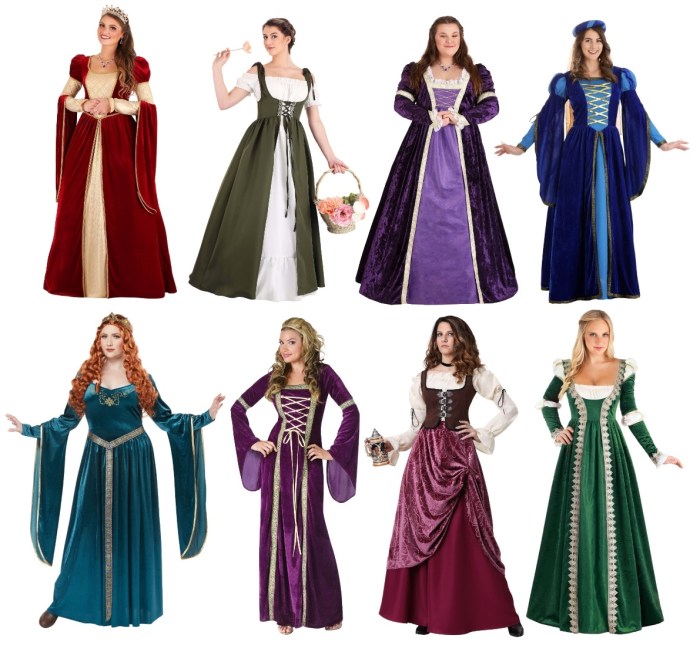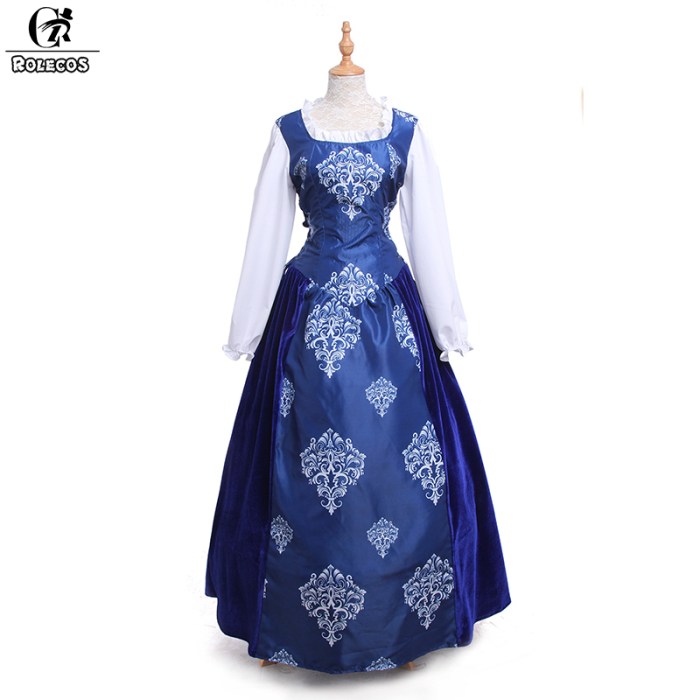Renaissance Festival Dresses: Step back in time and explore the captivating world of Renaissance fashion. From the rich fabrics and intricate construction techniques to the social significance and symbolism embedded within each garment, Renaissance festival dresses offer a fascinating glimpse into a bygone era. This guide delves into the historical accuracy, stylistic variations, and modern interpretations of these iconic costumes, revealing the artistry and cultural context behind their enduring appeal.
We’ll uncover the secrets behind the farthingale, the stomacher, and the ruff, examining the evolution of Renaissance clothing across different social classes and geographical regions. We’ll also explore the creative liberties taken in modern adaptations, comparing them to historically accurate garments and discussing the practicality and functionality of both. Prepare to be transported to a world of vibrant colors, symbolic patterns, and exquisite detail, as we unravel the story behind Renaissance Festival Dresses.
Historical Accuracy of Renaissance Festival Dresses

Renaissance festivals offer a vibrant spectacle, transporting attendees to a romanticized vision of the past. However, the clothing on display often diverges significantly from the historical reality of the Renaissance period, a time of significant stylistic evolution spanning roughly from the 14th to the 17th centuries. Understanding the discrepancies between festival attire and authentic garments provides a richer appreciation for both the artistry of the period and the creative liberties taken in modern interpretations.
Evolution of Renaissance Clothing Styles
The Renaissance saw a dramatic shift in clothing styles, influenced by evolving social structures, trade routes, and artistic movements. Early Renaissance fashion, heavily influenced by the Gothic period, featured long, flowing lines, often with elaborate embellishments. As the period progressed, clothing became more tailored and form-fitting, reflecting a growing emphasis on the human form, as seen in the art of the time.
The introduction of new fabrics from the East, such as silks and velvets, added richness and texture to garments. Silhouettes changed considerably, with the rise of puffed sleeves, slashed garments revealing contrasting fabrics underneath, and the increasingly prominent use of corsets to shape the female form. By the late Renaissance, a more ornate and elaborate style prevailed, culminating in the opulent fashions of the Elizabethan era.
Comparison of Festival and Historical Garments
Renaissance festival attire often borrows elements from various periods within the Renaissance, sometimes blending them anachronistically. While many costumes incorporate period-inspired details like ruffs, farthingales, and doublet jackets, they frequently lack the historical nuance and accuracy found in genuine garments. For example, festival dresses may feature overly vibrant colors or overly simplified construction compared to the intricate tailoring and rich embellishments of authentic garments.
The use of modern fabrics and construction techniques also significantly alters the drape and feel of the clothing. While a festival dress might evoke the general style of a particular era, a direct comparison with historically accurate garments reveals significant differences in silhouette, detail, and overall aesthetic.
Inaccuracies in Modern Interpretations
Several inaccuracies commonly appear in modern interpretations of Renaissance clothing found at festivals. One common issue is the simplification of construction. Historically accurate garments often involved complex tailoring techniques, such as slashing and piecing, which are rarely replicated in festival attire. The use of modern, mass-produced fabrics further contributes to a lack of authenticity. The rich textures and subtle variations in color and weave found in historical fabrics are often absent in their modern counterparts.
Furthermore, the embellishments and accessories frequently differ. Historically accurate garments often featured intricate embroidery, beading, or metallic thread work, which is often simplified or omitted in festival clothing. The use of historically inaccurate jewelry or accessories further contributes to the discrepancy. Finally, the overall silhouette and fit often deviate significantly from historical garments. The dramatic shapes achieved through the use of specific undergarments and tailoring techniques are frequently absent in festival costumes.
Social Significance of Renaissance Clothing, Renaissance Festival Dresses
Clothing during the Renaissance held profound social significance, acting as a powerful indicator of wealth, status, and social standing. The materials used, the quality of the tailoring, and the style of the garment all communicated information about the wearer’s position in society. Elaborate gowns and richly embroidered fabrics signaled wealth and high social status, while simpler garments indicated lower social standing.
Specific styles of clothing also became associated with particular professions or social groups. Understanding the social context of Renaissance clothing allows for a more nuanced appreciation of the historical significance of the garments, and highlights the limitations of the simplified representations found at many Renaissance festivals.
Modern Interpretations and Adaptations

Renaissance festival dresses, while often inspired by historical garments, frequently diverge significantly from their 16th-century counterparts. This divergence isn’t necessarily a negative; it reflects a modern aesthetic sensibility and a focus on practicality and comfort that simply weren’t priorities for historical dressmakers. The result is a vibrant and evolving style that blends historical influences with contemporary design choices.The chasm between historically accurate and modern Renaissance festival attire is substantial.
While historically accurate garments prioritized functionality and reflected the social status of the wearer through fabric choices and construction techniques, modern interpretations prioritize aesthetics and comfort. This means prioritizing a visually appealing look, often at the expense of complete historical fidelity.
Stylistic Choices in Modern Renaissance Festival Attire
Modern Renaissance festival dresses frequently incorporate elements that would be anachronistic in a historically accurate context. These choices are driven by both aesthetic preferences and the demands of a modern festival environment. For example, the use of vibrant, jewel-toned fabrics is commonplace, even though such richly colored dyes were less readily available during the actual Renaissance. Similarly, modern designs often feature lower necklines and shorter hemlines than their historical equivalents, reflecting contemporary fashion sensibilities.
Bodices might be simplified, omitting complex lacing or boning structures found in authentic garments. Sleeves might be modified for greater comfort and ease of movement, foregoing the elaborate puffs and slashes characteristic of some historical styles. Finally, the incorporation of modern fabrics, such as comfortable cotton blends or stretch materials, contributes to a more wearable and practical garment, unlike the heavier, less forgiving fabrics often used in the Renaissance period.
Practicality of Modern Adaptations versus Original Garments
The practicality of modern Renaissance festival dresses significantly surpasses that of their historical counterparts. Original Renaissance garments were often heavy, cumbersome, and required significant time and effort to put on and take off. Modern adaptations, by contrast, prioritize comfort and ease of movement. The use of lighter fabrics and simpler construction techniques makes them significantly more comfortable for hours of walking, dancing, and participating in festival activities.
Modern designs often include features like hidden pockets, zippers, and adjustable closures, which enhance both comfort and practicality, features absent from their historical predecessors. Consider the difference between attempting a complex lacing system on a hot summer day versus slipping into a modern dress with a simple zipper closure. The contrast is stark, highlighting the increased comfort and ease of the modern approach.
Creative Liberties in Modern Renaissance Festival Dress Design
Modern designers take significant creative liberties, resulting in a wide array of styles that draw inspiration from the Renaissance but are not strictly replicas. This creative freedom leads to a diverse and visually stunning array of garments. For example, designers might combine elements from different periods or regions within the broader Renaissance era, creating a unique and visually interesting hybrid style.
They might also incorporate elements from other historical periods or even fantasy settings, resulting in dresses that are distinctly modern in their interpretation of the Renaissance aesthetic. The use of modern embellishments, such as beading, embroidery, and appliqué, further distinguishes modern dresses from their historical counterparts. Essentially, modern Renaissance festival dresses represent a creative dialogue between historical inspiration and contemporary design, creating a unique and visually engaging style.
Renaissance Festival Dresses are more than just costumes; they’re living testaments to a rich historical period, blending artistry, social commentary, and creative expression. Understanding the historical context, construction techniques, and symbolic meaning behind these garments enriches the experience of both wearing and appreciating them. Whether you’re a history enthusiast, a fashion aficionado, or simply curious about the past, the world of Renaissance festival dresses offers a captivating journey through time and style.